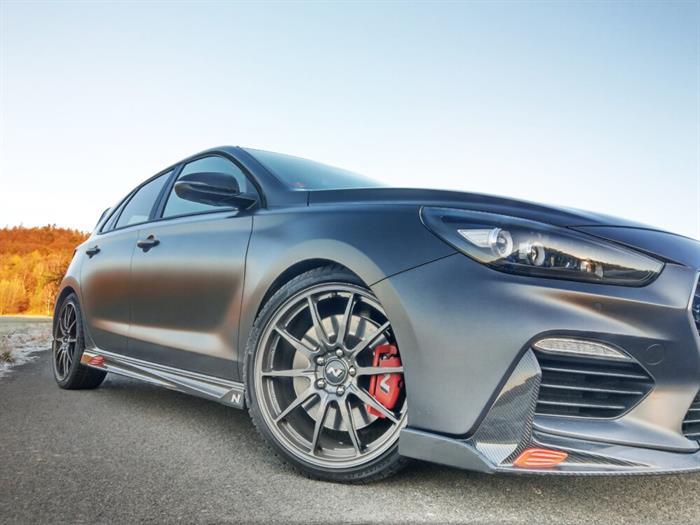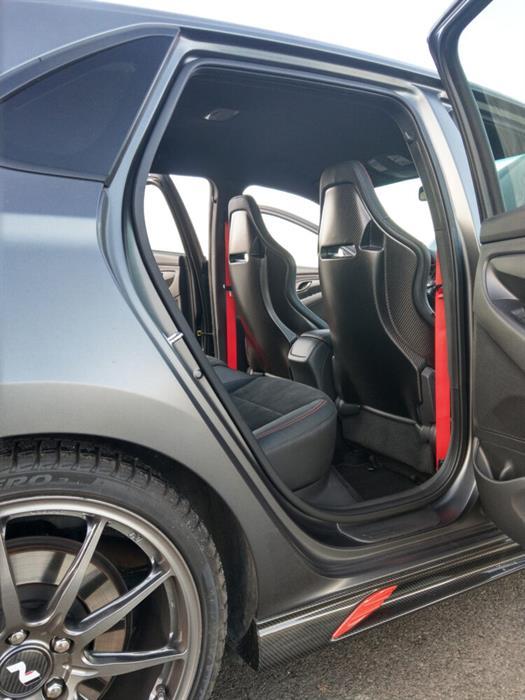Six hundred units were produced in total, of which seven cars were intended for the Czech market. So with such numbers, the new limited edition of the Hyundai i30N, the Project C version, was presented to the world.
The number of cars produced refers to the number of employees from Division N who participated in the birth of this limited edition. The letter "C" then refers to the "C" area (a test circuit in Korea intended for testing high-performance models), then to "Carbon fiber" (i.e. carbon fiber, which is widely used on the car) and last but not least to "Centre of gravity" (the current lowering of the center of gravity gives the car even better driving dynamics).
We have already informed you several times in the past about how the i30N Performance , the basis of the tested limiter, is a great car. So you already know that this is a sharp hot-hatch that very willingly changes its driving characteristics, from a calm companion for everyday driving to a beast that offers a massive pull, automatic intermediate gases, or quite a loud speech thanks to an active flap in the exhaust.
The currently tested limited edition goes one step further. The modifications made to the car have sharpened its handling and added some purely functional frills.

Limited edition i30 N Project C
You can safely recognize the limited edition Project C by the stylish gray paint, carbon parts and contrasting red lacquered accessories. A more careful observer will not miss the shell front seats or the steering wheel covered with alcantara.
However, Project C is not only about optical retouches, the main thing it comes with is weight reduction. So let's focus on the individual parts that helped him achieve a relatively significant 50-kilogram weight saving.

The biggest saving was brought by the very handsome OZ Racing forged wheels (- 22 kg), another significant saving was the replacement of the front seats, which were replaced by very attractive and functional shells from the Sabelt company (- 15 kg), and we also have a carbon hood ( – 7.2 kg). The side skirts alone have saved 1kg and the redesigned rear diffuser has saved another 0.5kg.
Work was also done on the "céčko" chassis, it received adaptive shock absorbers with shorter and lower springs. The chassis was therefore reduced by 6 mm and at the same time the center of gravity of the car went down. As part of the rear axle, we have new aluminum hinges and hubs, i.e. another kilo down.

In the interior, the most noticeable at first glance are the previously announced shells, which look simply great, are elegantly subtle and their carbon "back" looks really impressive. Their shaping will offer a good posture, but ideally for a slimmer figure of a competitor. The shells are then manually adjustable and their subtlety offers a lower position behind the wheel.
Another distinctive element of this limiter is the steering wheel covered with alcantara. Those magical buttons on the steering wheel are still here, but they are colored red, like the seat belts or the interior stitching.
The driver's workplace is a newly equipped aluminum shifter head, which although looks very impressive, can get quite dirty at this time of year.
Within the dashboard, everything is the same as before, the simple and clear "deck" does not significantly surprise, but does not offend either. However, it finally comes with one change, that change is a plaque with a car number, in our case 506/600.

Motorization and driving characteristics
In terms of motorization, the limited edition Project C "unfortunately" did not have any news for us. It is still powered by the old excellent turbocharged two-liter engine with an output of 202 kW and a torque of 353 Nm. This motorization also cooperates with an excellently graded six-speed manual.
After the first few meters, it is clear to you that the modifications made to the chassis had a noticeable effect on its hardness. In connection with the subtle shells, the car therefore quite willingly informs you about every hole in the asphalt.
The first batch of kilometers traveled is quite cautious on my part, the stiff chassis and the modest number of units produced keep me constantly on my guard. But gradually I rub myself and switch to the mode that I remember well from the previously tested i30 N Performance cars.
Thanks to the stiffer chassis, the car loves corners even more and is very confident in them, wiping one after another at high speed. You won't lose precious seconds even on the exit from the corners, because the car is equipped with an excellent self-locking system.
The steering, which is very precise and quite steep, is also worthy of praise. The six-speed manual, which is also unchanged, will offer short and precise shifting paths.

The Hyundai i30 N Project C also retained a significant difference in behavior depending on the selected driving mode. The "Céčko" therefore continues to have the classic ECO, NORMAL and SPORT modes, which you select with the left button on the multifunction steering wheel. The right button then activates the sharp "N" mode and the fully adjustable "CUSTOM" mode. The listed driving modes have an overlap mainly in engine response, differential operation, exhaust volume, adaptive damper settings, power steering efficiency settings, electronic stability control settings, etc.
After starting the car, the NORMAL mode is always activated, in which the classic N Performance presented itself as a "family" hatchback with a stiffer chassis and steering. With Project C, it is already noticeably different, thanks to the announced hardness of the chassis.
Another mode is ECO, which I used quite a lot during long journeys on the highway, when you have a comfortable highway speed set on the cruise control and you enjoy quite "calm" driving. Enko will repay you in this situation with a very respectable consumption of around 8.5 liters per 100 km.
The Sport mode is already quite different, the settings of everything except the ESC will change. The response to the gas pedal accelerates, the chassis and power steering stiffen, the differential's grip increases, and there is also a change in the sides of the response from the exhaust, which is then significantly more "eloquent".
The real hell then begins when you activate the “N” mode, which will intensify everything even more. The chassis itself is much stiffer and the engine revs even more willingly. An interesting feature is the Rev-Matching function, which adequately equalizes the engine speed when downshifting – this is a significantly faster reaction than with classic intermediate gases. The "N" mode is more of a circuit mode, the chassis is really very hard and almost unusable on urban surfaces.
CUSTOM mode, in which you can personalize all parameters of the car's settings, becomes a release. The ideal combination for me was to set the steering and chassis to NORMAL and everything else to SPORT +. Enko is pleasantly explosive and powerful with a pleasant booster effect and with a bearable chassis hardness.
On the consumption side, I have already described the idle mode, in the sharp mode the consumption will shoot well above ten liters, proportional to your driving style. So on average, count on a consumption of around 12 liters per 100 km.
As a result, it's actually simple, Project C just takes the excellent driving characteristics of the N Performance version one step higher. The interplay between the engine, transmission, differential, chassis and steering makes the car a real driver's car to get used to. The car certainly doesn't give you anything for free, but driving it is authentic and simply great.

In conclusion
Both the sharp versions and the 30, i.e. the N and N Performance versions, always offered an interesting price policy in terms of the purchase price. You can buy both the basic and 30 N with a 184 kW turbocharged two-liter from just under 700,000 CZK including VAT. The N Performance version with a 202 kW turbocharged two-liter is then 40,000 CZK more expensive.
The limited edition Project C had a price set at 999,990 CZK including tax. All seven pieces, with the exception of the tested journalist, intended for our market, were hopelessly sold out immediately.
Nevertheless, I was struck by the still active offer on the website and the physical presence of one of the cars on the dealer's sales floor. I then received a clear answer to my question about the current availability of this car. Due to the great interest, we managed to get another twenty cars from Germany. More than ten pieces are currently available within the dealer network.
The Hyundai i30 N Project C is not that much more fun to drive for me because it is more expensive compared to the classic i30N Performance . Yes, it will offer a noticeably stiffer and more aggressive driving performance, but that makes it less usable for everyday driving. On the other hand, you will definitely not buy this limit for everyday driving.
So I see its main added value in a certain uniqueness and exceptionality. In addition, this superbly driven limited edition will certainly have a certain collector's value.
Source: Author's text
Image source: Author's own photos






























